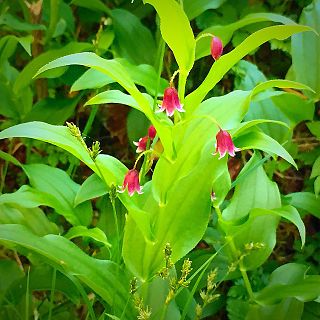
Syringa is a genus of 12 currently recognized species of flowering woody plants in the olive family or Oleaceae called lilacs. These lilacs are native to woodland and scrub from southeastern Europe to eastern Asia, and widely and commonly cultivated in temperate areas elsewhere.

Adenophora is a genus of flowering plants in the family Campanulaceae, the bellflowers. Plants of this genus are known commonly as ladybells. Most are native to eastern Asia, with a few in Europe. Many are endemic to either China or Siberia.

Aletris, the colicroot, colicweed, crow corn, or unicorn root, is a genus of flowering plants in the family Nartheciaceae, native to North America and to eastern and southeastern Asia, especially China. It was used as a component in Lydia Pinkham's original Vegetable Compound.

The genus Helwingia consists of shrubs or rarely small trees native to eastern Asia, the Himalayas, and northern Indochina. It is the only genus in the family Helwingiaceae.

Linnaea is a plant genus in the honeysuckle family Caprifoliaceae. Until 2013, the genus included a single species, Linnaea borealis. In 2013, on the basis of molecular phylogenetic evidence, the genus was expanded to include species formerly placed in Abelia, Diabelia, Dipelta, Kolkwitzia and Vesalea. However, this is rejected by the majority of subsequent scientific literature and flora.

Caryopteris is a genus of flowering plants in the family Lamiaceae. They are native to east Asia.

Kobresia is a genus of plants in the sedge family. They are sometimes called bog sedges. These perennial sedges are quite similar to Carex species in appearance. The genus is widespread across much of Europe, Asia and North America, with many species native to the Himalayas.

Cypripedium henryi, Henry's cypripedium, is a species of orchid endemic to China. It is found in southern Gansu, Guizhou, western Hubei, southern Shaanxi, southern Shanxi, Sichuan, and northwestern to southeastern Yunnan. It grown in humus-rich places in open forests, at forest margins, or on scrubby slopes at elevations of 800–2,800 m (2,600–9,200 ft) above sea level.

Nemosenecio is a genus of East Asian flowering plants in the groundsel tribe within the sunflower family.
Soroseris is a genus of Asian plants in the tribe Cichorieae within the family Asteraceae.
Nannoglottis is a genus of Asian flowering plants in the family Asteraceae.
Nelsonianthus is a genus of flowering plants belonging to the family Asteraceae.
Psacaliopsis is a genus of Mexican plants in the groundsel tribe within the daisy family.

Streptopus is a Eurasian and North American genus of flowering plants in the lily family, found primarily in colder and temperate regions. Members of the genus are often referred to as twistedstalk. It is one of the shade-loving genera of the lily family.
Hiroshige Koyama (1937–2016) was a Japanese botanist and specialist of Asteraceae.
Schnabelia is a genus of plants in the family Lamiaceae, first described in 1921. The entire genus is endemic to China.
Oreta hoenei is a moth in the family Drepanidae. It was described by Watson in 1967. It is found in China.

Parapsestis tomponis is a moth in the family Drepanidae. It was described by Shōnen Matsumura in 1933. It is found in Taiwan, Vietnam and the Chinese provinces of Henan, Shaanxi, Gansu, Hubei, Hunan, Fujian, Sichuan, Guizhou and Yunnan.
Acer caesium, the Himalayan maple, is an Asian species of maple found in India, Pakistan, Nepal, and China.

Acer stachyophyllum is an Asian species of maple. It is native to China, Myanmar, northern India, Bhutan, and Nepal.















